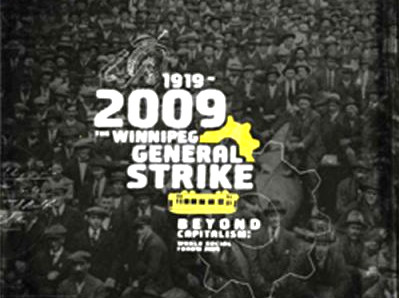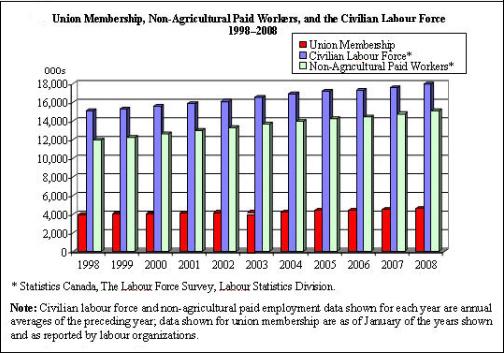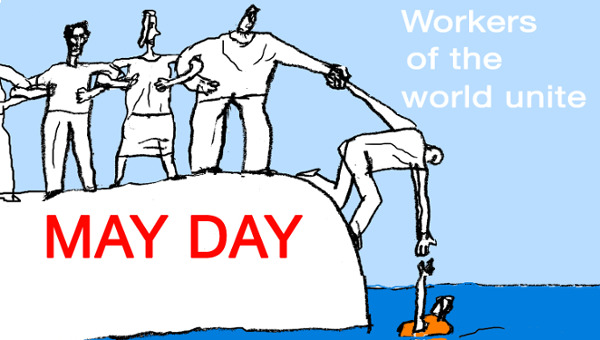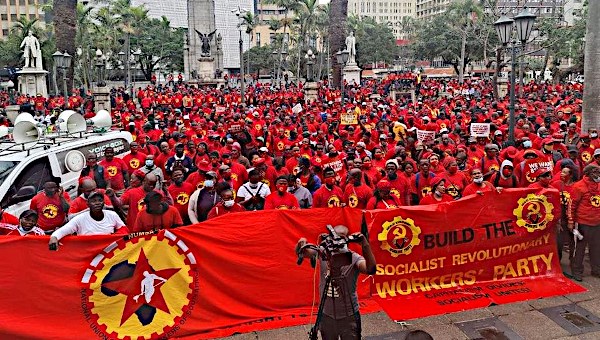Unions and the Crisis: Ways Forward?
This May Day, the day of celebration of the international working class movement, arrives in the midst of an international crisis of capitalism.
For the first time since the 1930s, the world economy is expected to shrink. As a result, some 50 million workers are being added to the numbers of unemployed; migrant workers as most often the first laid-off are being pushed into ever further and more precarious searches for work; women workers are under strain to both earn more income and assume greater responsibilities for childcare and families; and the beginning efforts to deal with catastrophic climate changes are being subordinated to efforts by corporations and states to re-establish profits and growth. At the same time some $5-trillion has been given over to rescuing the financial system after years of reckless speculation and endless greed. And the imperialist states of Europe and North America continue to engage and finance wars and occupations across the Middle East and military expansion around the globe. It has never been clearer that capitalism is quite capable of producing social barbarism and unfathomable levels of economic wreckage.
May Day provides an important opportunity, particularly in Canada and the U.S. which remain at the centre of the capitalist world economy, to make a sober evaluation of the state of the workers’ and socialist movements. This is the initial point of beginning the renewal of the movements. Looking back over the more than 100 years of May Day there is a lot to build on – from the initial struggles for the eight hour day, to the spread of union and welfare rights, to the numerous revolts and revolutions of workers’ movements against oppressive ruling classes and for the vision of building a new social order. After this long nightmare of neoliberalism, there is now a new common-sense of the need for organizational renewal on the Left as part of discovering a 21st century socialism. This is found in the struggles of the Bolivarian governments in Latin American, the Nepalese peasant revolt, and the new radical left formations that are beginning to breakthrough in Europe. A ‘new’ Left is emerging. This is making it all the more important that the North American Left and union movement begin to look beyond its own current disarray and rediscover some political daring and creativity.
Here The Bullet presents an assessment of the union movement in the midst of this economic crisis from Greg Albo, and a celebration of the history of May Day from Leo Panitch. More than ever, in the midst of global economic crisis, on this May Day: workers of the world unite!
Unions and the Crisis: Ways Forward?
Greg Albo
The political and economic setting facing the union movement today is, perhaps, the most difficult since the Great Depression. Unions had already confronted two decades of unrelenting assault from neoliberal policies of labour market flexibility, austerity and political conservatism. Then, the global financial crisis triggered by defaults in the U.S. subprime mortgage market starting in 2006 ripped across the entire world market. Indeed, many forecasts for 2009 are projecting negative growth for the world economy as a whole for the first time since the 1930s. It is no longer uncommon to hear discussion of the possibility of depression from the most apologetic for capitalism.
 The extent of the economic slowdown already makes for sober reading. In the fourth quarter of 2008, economic output fell, on an annualized basis, by six percent in both the U.S. and the Euro zone, and an astonishing 12 and 20 percent in Japan and Korea respectively. Chinese economic growth has also been cut in half, and exports have fallen by 40 to 50 percent across East Asia. No zone of the world market is being insulated. Canada’s economic growth has also turned negative, and forecasts suggest negative growth in the order of two to three percent for 2009.
The extent of the economic slowdown already makes for sober reading. In the fourth quarter of 2008, economic output fell, on an annualized basis, by six percent in both the U.S. and the Euro zone, and an astonishing 12 and 20 percent in Japan and Korea respectively. Chinese economic growth has also been cut in half, and exports have fallen by 40 to 50 percent across East Asia. No zone of the world market is being insulated. Canada’s economic growth has also turned negative, and forecasts suggest negative growth in the order of two to three percent for 2009.
The tally of financial losses is quite staggering. The Asian Development Bank has estimated that financial assets worldwide have declined by some $50-trillion (which is about the same amount as annual global output). Western banks have written down about $1-trillion in assets, and estimates run from $3 to $5-trillion of losses in the banking sector alone. The U.S. government alone has already committed $9-trillion to its financial sector in various forms to maintain solvency. The sheer magnitude of the debt means that depressed economic conditions are likely to be long-lasting, and the distributional struggles very intense over how the bad debt – ‘toxic assets’ is the euphemism of the day to disguise the massive market failure and incompetency of the financial sector – is destroyed, socialized or inflated away.
The financial chaos is causing untold damage to workers. The International Labour Organization (ILO) has suggested that global job losses could reach as high as 51 million for 2009. In Canada, the devastation in the labour market is already immense. Unemployment has already climbed to 7.7 percent, with almost 300,000 jobs being lost since October alone, and almost all new jobs created being part-time.
Capitalist Strategies
It is impossible to calculate how deep or prolonged the economic recession might be. Competitive imperatives will compel capitalist firms (as well as state employers) to restructure workplaces and challenge union contracts. This will build on what is now a three decades old ‘employers’ offensive.’
The offensive emerged in the late 1970s as capitalists attempted to restore company profitability and control over the labour process after considerable erosion over the postwar boom. The rate of profit had fallen by about half over the postwar decades across virtually all zones of the world market. The fall was especially sharp in North America. The decline in profit rates coincided with a push by unions and workers to gain an increasing share of output, to expand public services and to address inequalities facing women and racial minorities. These efforts were backed by the largest and longest strike wave in the history of the advanced capitalist countries – with Canada consistently leading in days lost due to strikes – from the mid-1960s to across the 1970s.
Union Membership in Canada, 1998–2008

Source: Human Resources and Skills Development Canada
| Year | Union Membership | Civilian Labour Force | Non-Agricultural Paid Workers | Union Membership as a % of Civilian Labour Force | Union Membership as a % of Non-Agricultural Paid Workers |
|---|---|---|---|---|---|
| (000s) | (000s) | (000s) | % | % | |
| 1998 | 3,938 | 15,079 | 11,964 | 26.1 | 32.9 |
| 1999 | 4,010 | 15,316 | 12,212 | 26.2 | 32.8 |
| 2000 | 4,058 | 15,588 | 12,603 | 26.0 | 32.2 |
| 2001 | 4,111 | 15,847 | 13,027 | 25.9 | 31.6 |
| 2002 | 4,174 | 16,110 | 13,304 | 25.9 | 31.4 |
| 2003 | 4,178 | 16,579 | 13,650 | 25.2 | 30.6 |
| 2004 | 4,261 | 16,959 | 13,965 | 25.1 | 30.5 |
| 2005 | 4,381 | 17,182 | 14,265 | 25.5 | 30.7 |
| 2006 | 4,441 | 17,343 | 14,464 | 25.6 | 30.7 |
| 2007 | 4,480 | 17,593 | 14,782 | 25.5 | 30.3 |
| 2008 | 4,592 | 17,945 | 15,111 | 25.6 | 30.4 |
Source: Human Resources and Skills Development Canada, and Statistics Canada, The Labour Force Survey.
The capitalist classes responded with a number of strategies to the union militancy and declining profits. At the level of the state, neoliberal policies from the 1980s on deregulated markets, imposed fiscal austerity, cut welfare, liberalized trade and capital flows and so on. In terms of workplaces, this meant increased ‘flexibility’ in terms of job controls, wages and employment.
In terms of wages, for example, the focus was on curbing real wage gains for workers and breaking a linkage between productivity gains and annual wage improvements. More of output increases would thus go toward profits. This initially occurred in the 1970s via inflation eroding bargained money wages. But from the 1980s on it came in the form of pressures from high unemployment rates restraining collective bargaining demands. Except for a few years, the wage austerity has been unrelenting.
A number of other strategies radically reshaped work relations. Firms have re-organized their labour processes into international production networks and shifted work into low-wage, weak-union production zones. Information and communications technologies have facilitated the introduction of ‘lean production’ intensifying work processes. Employers have broken with ‘standard’ work arrangements and increasingly resort to contingent work arrangements, cheap migrant labour pools and temporary work programmes. In collective bargaining, unions increasingly trade-off wage restraint and workplace concessions against job security, agree to co-management schemes for firm competitiveness, and even enter into ‘voluntary recognition agreements’ to gain members while giving up the right to strike and other job controls. The employers’ offensive has made ‘competitive unionism’ the dominant practice, in both the public and private sectors, in North America.
The economic crisis has made employers even more militant in their demands for wage austerity and concessions. One strategy has been cuts to negotiated health benefits (insurance plans in the U.S.) for current employees and retirees, as well as other benefits. Another emerging strategy is to redefine – or even walk away from – pension obligations, as has occurred in the steel and auto sectors and in numerous non-unionized companies. Work intensification is also occurring as workers are being pushed to give up time-off, holidays, work breaks, and so forth. And capitalists are increasingly using bankruptcy proceedings (or the threat of it) to crack open union contracts and demand sharp cuts to wages and benefits. The airline and steel industries in both Canada and the U.S. have adopted this strategy; it is now most visible in the auto manufacturing and parts sectors. In the public sector, such cuts have long been a consequence of privatization.
The underlying logic of all these strategies remains shifting the share of new value produced toward company profits and away from workers’ wages and expanding public services. There is little in current collective bargaining that is not reinforcing the worst features of neoliberalism.
New Political Openings?
Up to the financial crisis, these capitalist strategies proved quite successful in re-establishing profitability and capitalist power. This is not to say that growth was at same pace as the postwar period or that economic hardship did not result for most workers. As Marx pointed out in Capital, the ‘general law of capitalist accumulation’ is the amassing of profits and wealth at one pole and a reserve army of labour and social needs left unmet at another.
Marx also argued in Capital that each phase of accumulation contained the seeds of its own destruction. The internal contradictions of neoliberalism are now readily apparent: fictitious capital and debt massively growing relative to the growth of productive capacity and the deterioration of public services; wage compression leading to increasingly indebted working classes and unstable conditions for effective demand; the undermining of extra-market regulatory capacities to constrain capitalist competition, speculative bubbles and fraud as an endemic feature of financialization; and huge international payments imbalances reinforcing dependence on the world market while spreading its potential instabilities.
Neoliberal and free market ideology is now totally discredited. But capitalist strategies and government policies are attempting to reconstruct neoliberalism as the basis for again restoring capitalist profitability. This is the political challenge the union movement now faces.
Many union activists had already been pointing out for some time that conventional collective bargaining strategies and union politics were only leading to further setbacks and concessions. The economic crisis has now made this obvious to everyone. Existing union strategies are neither confrontational enough to challenge capitalist workplace strategies after years of concessions. Nor are they politically ambitious enough to form the necessary anti-capitalist strategies to form the political agendas and organizational capacities to forge an alternate approach to the crisis.
There are, however, several hopeful signs of union renewal that could begin to chart a new direction. In North America, some of this has come from ‘living wage’ struggles led by local labour councils in major cities, in alliance with community groups, to reach out to the low-waged and unorganized, who are predominantly women and people of colour. The mass immigrants’ rights May Day protests, as well as the day-to-day campaigns for the protection of non-status workers, have taken place outside the main union movements, but also led to new linkages and alliances. A number of campaigns – notably some of the anti-privatization struggles around healthcare, universities and municipal services – have had successes across several countries. These community-union alliances, often coupled with major campaigns and demonstrations, suggest enormous potential.
There also have been interesting examples of a new organizational internationalism amongst unions. The efforts to coordinate aspects of collective bargaining in the steel, auto and healthcare sectors, extending from North America to both Europe and Latin America, to confront work issues spread across international production networks, is one example. The campaign against the militantly anti-union Wal-Mart is also suggestive. International solidarity campaigns, such as those with Palestinian workers in the Occupied Territories and inside apartheid Israel, against the continued assaults on unionists in Columbia, for the rights of migrant workers, or for the rights of workers in countries like Venezuela to experiment in workers’ control, also are promising signs of organizational renewal.
In the context of the economic crisis, it is necessary to form a set of demands that might converge across different struggles and sectors to embed an anti-market logic in bargaining that might offset the worst features of the slowdown. In terms of workplace struggles, a core set of campaigns might be:
- the fight against concessions in wages and benefits;
- in the preservation of negotiated pensions;
- building in annual reductions in work-time within wage negotiations;
- support for plant occupations and community seizure of assets, particularly in cases of bankruptcy and firms receiving state subsidies; and
- extension of all other forms of hours reduction in terms of parental leaves, annual holidays, over-time, and so on.
A set of union demands directed at the economic crisis is also important:
- the overhaul or unemployment insurance systems in terms of benefits, principles of eligibility and administration;
- industrial strategies directed at ecologically responsible production;
- massive extension of ‘green jobs’ in the culture, leisure, and sporting sectors;
- nationalization of the banking sector;
- building a national childcare system;
- nationalization of the transportation sector and development of a national mass transit strategy; and
- establishment of a national housing programme.
Ways Forward
These types of demands, of course, have been percolating through the union and socialist movement for some time. They would also require the formation of basic planning capacities in a quite different kind of state than now exists. They will receive no support from the ruling class power structures in Canada or the USA. They will depend on reversing the decline of the union movement and the wider impasse of the Left. Working class political organization has in the past achieved a great deal: leading de-colonisation struggles; campaigning for the expansion of freedoms and equality to women and racial and sexual minorities; improving wages and benefits; and agitating for the extension of universal welfare states.
The social forces that achieved these gains are now quite something else: the communist parties have all but disappeared even in places where they once held power (or they have made their peace with capitalism as in China); the social democratic parties now chart a ‘Third Way’ and no longer even pose a reform agenda to neoliberalism; unions are in retreat; and many civil society movements have evolved into professionalised NGOs navigating the grant economy. The central political coordinates for labour movements over the last century – being for or against the Russian revolution; attempting a vanguard seizure of the existing state apparatus or reforming it piecemeal; conceiving unions as primarily the industrial wing of this or that political party – no longer provide any kind of map for the struggles unions and workers now confront.
For a brief moment, it seemed as if a decentralized ‘network politics’ – a ‘movement of movements’ – would provide, if not a map for the future, a renewed political capacity for the Left. It was represented in the hopeful ‘Teamsters and Turtles’ slogan of the heady days of the anti-globalization movement. But apart from episodic demonstrations and annual social justice fairs, the networks have broken apart more often than they have provided new organizational nodes. There has been almost a complete lack of organizational grounding in the day-to-day struggles of working class communities, workplaces and unions.
This ‘anti-power’ politics is now being eclipsed by new political experiments beginning from – and not against – organizational commitments to unions and political parties. In Latin America, this has taken place under the banner of building 21st century socialism in a number of countries. A ‘new’ New Left appears to be emerging from the margins in Greece, Germany, France, Portugal and other places as well.
Under the pressure of events, some sections of the North American Left are also beginning to pose the question of how to build anti-neoliberal – and at times anti-capitalist – alliances and a new political organization of a pluralist Left. From their anchor in workplace struggles and in particular communities, a renewed union movement is a crucial component of such a new Left. Indeed, in representing the deep diversity of workers and their issues – in terms of gender, racial background, sexual diversity, and so forth – unions have been leading society in this area over the period of neoliberalism rather than following it.
Moving on will require forming new political capacities and an organizational openness and creativity that the Left in North America has not shown for some time. The long decline of unions in the face of powerful capitalist strategies to restore their power over the neoliberal period had already made this clear. It has now become an imperative. That realization is always the point of a new beginning.
A version of this appeared in Canadian Dimension.
What you need to know about May Day
Leo Panitch
For more than 100 years, May Day has symbolized the common struggles of workers around the globe. Why is it largely ignored in North America? The answer lies in part in American labour’s long repression of its own radical past, out of which international May Day was actually born a century ago.
The seeds were sown in the campaign for the eight-hour work day. On May 1, 1886, hundreds of thousands of North American workers mobilized to strike. In Chicago, the demonstration spilled over into support for workers at a major farm-implements factory who‘d been locked out for union activities. On May 3, during a pitched battle between picketers and scabs, police shot two workers. At a protest rally in Haymarket Square the next day, a bomb was tossed into the police ranks and police directed their fire indiscriminately at the crowd. Eight anarchist leaders were arrested, tried and sentenced to death (three were later pardoned).
These events triggered international protests, and in 1889, the first congress of the new socialist parties associated with the Second International (the successor to the First International organized by Karl Marx in the 1860s) called on workers everywhere to join in an annual one-day strike on May 1 – not so much to demand specific reforms as an annual demonstration of labour solidarity and working-class power. May Day was both a product of, and an element in, the rapid growth of new mass working-class parties of Europe – which soon forced official recognition by employers and governments of this “workers’ holiday.”
But the American Federation of Labor, chastened by the “red scare” that followed the Haymarket events, went along with those who opposed May Day observances. Instead, in 1894, the AFL embraced president Grover Cleveland’s decree that the first Monday of September would be the annual Labor Day. The Canadian government of Sir Robert Thompson enacted identical Labour Day legislation a month later.
Ever since, May Day and Labour Day have represented in North America the two faces of working-class political tradition, one symbolizing its revolutionary potential, the other its long search for reform and respectability. With the support of the state and business, the latter has predominated – but the more radical tradition has never been entirely suppressed.
This radical May Day tradition is nowhere better captured than in Bryan Palmer’s monumental book, Cultures of Darkness: Night Travels in the Histories of Transgression [From Medieval to Modern] (Monthly Review Press, 2000). Palmer, one of Canada’s foremost Marxist labour historians, has done more than anyone to recover and analyze the cultures of resistance that working people developed in practising class struggle from below. He’s strongly critical of labour-movement leaders who’ve appealed to those elements of working-class culture that crave ersatz bourgeois respectability.
Set amid chapters on peasants and witches in late feudalism, on pirates and slaves during the rise of mercantile imperialism, on fraternal lodge members and anarchists in the new cities of industrial capitalism, on lesbians, homosexuals and communists under fascism, and on the mafia, youth gangs and race riots, jazz, beats and bohemians in modern U.S. capitalism, are two chapters that brilliantly tell the story of May Day. One locates Haymarket in the context of the Victorian bourgeoisie’s fears of what they called the “dangerous classes.” This account confirms the central role of the “anarcho-communist movement in Chicago [which] was blessed with talented leaders, dedicated ranks and the most active left-wing press in the country. The dangerous classes were becoming truly dangerous.”
The other chapter, a survey of “Festivals of Revolution,” locates “the celebratory May Day, a festive seizure of working-class initiative that encompassed demands for shorter hours, improvement in conditions, and socialist agitation and organization” against the backdrop of the traditional spring calendar of class confrontation.
Over the past century communist revolutions were made in the name of the working class, and social democratic parties were often elected into government. In their different ways, both turned May Day to the purposes of the state. Before the 20th century was out the communist regimes imploded in internal contradictions between authoritarianism and the democratic purpose of socialism, while most social democratic ones, trapped in the internal contradictions between the welfare state and increasingly powerful capital markets, accommodated to neoliberalism and become openly disdainful of “old labour.”
As for the United States, the tragic legacy of the repression of its radical labour past is an increasingly de-unionized working class mobilized by fundamentalist Christian churches. Canada, with its NDP and 30-per-cent unionized labour force, looks good by comparison.
Working classes have suffered defeat after defeat in this era of capitalist globalization. But they’re also in the process of being transformed: The decimated industrial proletariat of the global North is being replaced by a bigger industrial proletariat in the global South. In both regions, a new working class is still being formed in the new service and communication sectors spawned by global capitalism (where the eight-hour day is often unknown). Union movements and workers’ parties from Poland to Korea to South Africa to Brazil have been spawned in the past 20 years. Two more book out of Monthly Review Press – Ursula Huw’s The Making of a Cybertariat (2003) and the late Daniel Singer’s Whose Millennium? Theirs or Ours? (1999) – don’t deal with May Day per se, but capture particularly well this global economic and political transformation. They tell much that is sober yet inspiring about why May I still symbolizes the struggle for a future beyond capitalism rather than just a homage to the struggles of the past. •





